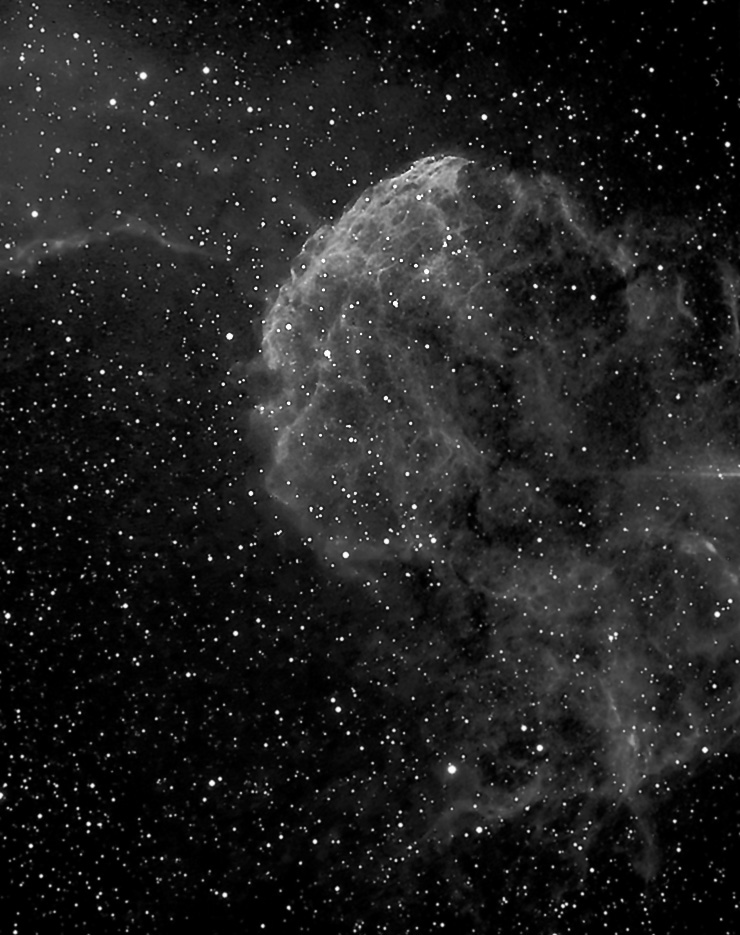|
12/6/2010: Tony Hallas is selling an 8-inch A-P, and to strut it's stuff Herb York displayed a photo of the Iris nebula made with it. Intriguing area! I wanted to see what I can do with 5/8ths of the aperture and a less efficient CCD. The field appears to be a wealth of dark and reflection nebulae in Cepheus. It will be just past the meridian at twilight and available for imaging for some time. How about 2-3 hours of luminance and half an hour of color data? A cloudy weather system is spinning over West Virginia. It closed school just up the mountain in Boone, and dropped 4-5 inches on Asheville. But the skies here have been clear, and while I can see the clouds the satellite shows off to the north, it seems well worth getting the gear fired up. Lesson One: calibrate using the right OTA. I lined up on Deneb, centered it on the guide chip, hit recalibrate, slewed to NGC 7023, the Iris Nebula, and took 75 minutes of luminance data. And no matter what I did, I couldn't seem to pull the nebula up from the central star. That's because the guide scope wasn't aligned with the imaging OTA, and I was taking data from the star next door, one about a degree away to the northeast. I reaimed both OTA's at the (unmistakable) center of M31 and recalibrated the mount. Lesson Two: bin color 2x2, use a flat, respect highlights. These I got right tonight. I decided to shoot M31 -- something I couldn't miss -- after my miscue with Iris. I shot 2.5 hours of 15 minute subs in luminance, and another 5, 100-second luminance frames to retain detail in the nuclear region. And I shot only 1x300s of color data in R, G, and B, binned 2x2. There was a nasty dark spot in one corner and some irritating dust circles in the L frames (at least), so [lesson two point one] I went out the next morning and shot a t-shirt flat. Truth be told, I didn't use a t-shirt, but let's not go into too much detail. One layer of cloth is not heavy enough to let the ST2000's shortest exposure work under a dawn sky; too bright. But the H-a filter darkened the chip just enough and the resulting flat resolved dust and shadow issues neatly. Averaging the 5, 100s frames in with the 10, 900s frames did not sufficiently protect the bright nucleus of M31 from burning out. I processed the 100s frames seperately and overlayed a feathered selection into the finished 900s luminance data. I also processed the RGB data seperately and added that in using Photoshop. In individual L frames, the two dark clouds near the center of the companion galaxy at top right are well shown. It's a fine detail that's almost lost in the version shown here. Work that out. The air was transparent but unsteady (a gusting wind above the pines made the trees roar from time to time). The blue supergiants in the starcloud in the lower right are mushed up into a cyan porridge owing to the poor seeing.
Messier 31, a galaxy in Andromeda
Lesson Three: shoot between the trees. not through them. I extended the luminance data on M31 by two frames (thirty minutes) while waiting for the Horsehead to emerge from behind a pine tree. I still started just a little early, and for my sins I lost a lot of green data on the east side of the image. That made color balancing much harder than it needed to be. After refocusing for H-a, I tried a couple of 300s G and B frames to make up the loss, but the results were uselessly blurred. Live and learn. I collected 7, 300s H-a frames before the top of a second pine tree began to intrude. The mix turned out well enough for starters, but obviously a lot more light is really needed to smooth it out, bring out the lovely details in IC 434, and establish the star colors with less straining at their histograms:
Alnitak with the Flame and Horsehead Nebulae in Orion
Lesson Four: Get some sleep! I slewed from the Horsehead to IC 443 and put Eta Geminorum off the chip to avoid its glare, then collected H-a data for the rest of the night. I called for 20 frames, which I knew was a few too many (the 20th would end near sunrise), but the first 16 look fine. 17 tracked into the roof, and 18 began to show daylight. Even so, 4 hours isn't enough of this faint nebula. The "shadows" have been stomped on pretty hard to control noise in this first look:
IC 443, the Jellyfish Nebula,
a supernova remnant in Gemini
The straight line reaching in from the right edge is the glare of third magnitude Eta Geminorum, 12-13 minutes of arc off the chip to the west. The next brightest star in the field is mid-7th magnitude, about 25 times fainter than hidden Eta. The temperature was around 22F when I started this image, about 16F at dawn. The thermoelectric cooler was having no trouble at all holding -40 on the chip. |
:: top ::
© 2010, David Cortner


